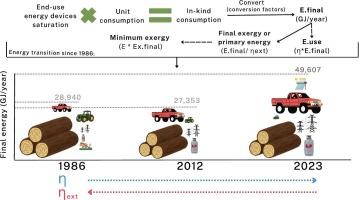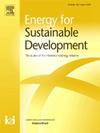墨西哥农村可持续能源转型的挑战:Cheranatzicurin村37年的比较分析
IF 4.9
2区 工程技术
Q2 ENERGY & FUELS
引用次数: 0
摘要
本研究对2023年墨西哥中部pursamuha农村社区的能源和能源消耗变化进行了全面的跟踪评估,并将结果与1986年和2012年进行的两项研究进行了比较。该案例研究通过整合传统经济或政策模型中经常被忽视的热力学约束因素,为农村能源现代化的社会环境影响的学术辩论做出了贡献。能源使用按最终用途应用、部门和能源载体分类,利用强大的混合方法数据集,包括结构化访谈、家庭调查、直接测量、无人机图像和详细的能源清单。主要发现包括:(a)对化石燃料的依赖显著增加,特别是运输部门的汽油,液化石油气、汽油和柴油现在占总能源消耗的近一半(44%),而1986年这一比例还不到10%;(b)人均能源需求增加35%(从11吉焦/年增加到17吉焦/年),尽管在制冷和私人交通等能源密集型服务扩大的推动下,终端使用效率有所提高,同时外部系统效率从92%下降到77%;(c)生物质能持续占据主导地位,95%的家庭仍在使用柴火做饭,强调现代和传统能源做法并存;(d)该村的整体第二定律效率持续较低,仅从1986年的8%增加到2023年的13%。这些发现挑战了线性农村能源转型的主流叙事——定义为从传统到现代、更清洁、更高效的技术的系统转变——揭示了一个非线性的、多维的过程,其特征是技术杂交、不平衡的采用率和社会差异化的影响。本文章由计算机程序翻译,如有差异,请以英文原文为准。

Challenges for a sustainable energy transition in rural Mexico: A 37-year comparative analysis for Cheranatzicurin Village
This study presents a comprehensive follow-up assessment of energy and exergy consumption changes in a Purépecha rural community in central Mexico for the year 2023, comparing the results with two previous studies conducted in 1986 and 2012. The case study contributes to the academic debate on the socio-environmental implications of rural energy modernization by integrating thermodynamic constraints—dimensions often overlooked in conventional economic or policy models. Energy use is disaggregated by end-use application, sector, and energy carrier, drawing on a robust mixed-methods dataset that includes structured interviews, household surveys, direct measurements, drone imagery, and detailed energy inventories.
Key findings include: (a) a marked increase in fossil fuel dependence—particularly gasoline in the transport sector—with LPG, gasoline, and diesel now accounting for nearly half (44 %) of total energy consumption, compared to less than 10 % in 1986; (b) a 35 % increase in per capita energy demand (from 11 to 17 GJ/capita-year) despite end-use efficiency improvements, driven by the expansion of energy-intensive services such as refrigeration and private mobility, and accompanied by a decline in external system efficiency from 92 % to 77 %; (c) the persistent dominance of biomass, with 95 % of households still using firewood for cooking, underscoring the coexistence of modern and traditional energy practices; and (d) a persistently low overall second-law efficiency for the village, increasing only from 8 % in 1986 to 13 % in 2023.
These findings challenge the dominant narrative of a linear rural energy transition—defined as a systematic shift from traditional to modern, cleaner, and more efficient technologies—revealing instead a non-linear, multidimensional process marked by technological hybridization, uneven adoption rates, and socially differentiated impacts.
求助全文
通过发布文献求助,成功后即可免费获取论文全文。
去求助
来源期刊

Energy for Sustainable Development
ENERGY & FUELS-ENERGY & FUELS
CiteScore
8.10
自引率
9.10%
发文量
187
审稿时长
6-12 weeks
期刊介绍:
Published on behalf of the International Energy Initiative, Energy for Sustainable Development is the journal for decision makers, managers, consultants, policy makers, planners and researchers in both government and non-government organizations. It publishes original research and reviews about energy in developing countries, sustainable development, energy resources, technologies, policies and interactions.
 求助内容:
求助内容: 应助结果提醒方式:
应助结果提醒方式:


